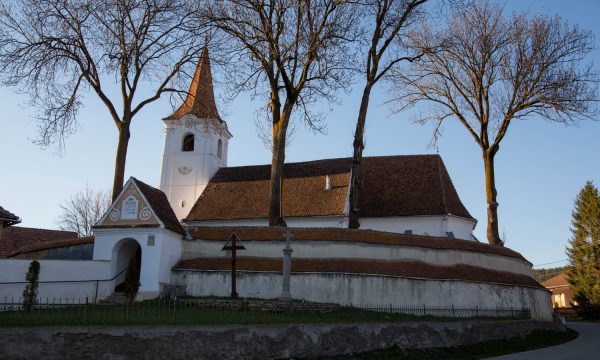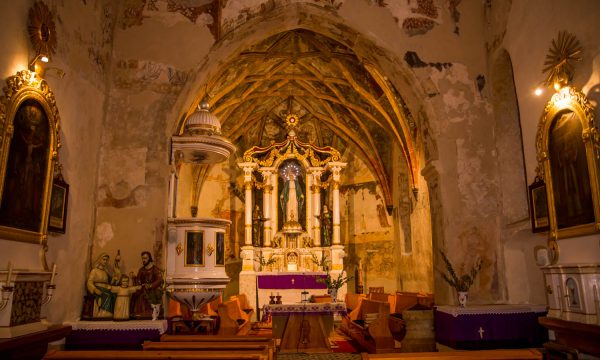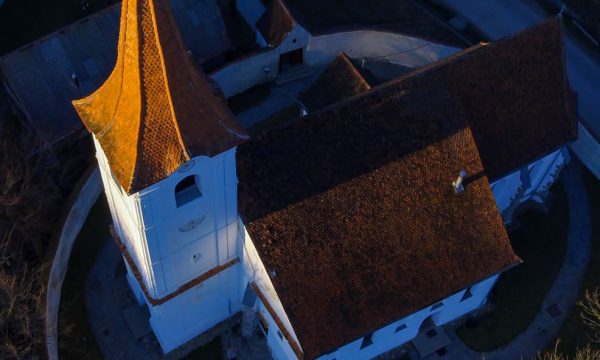Wall painting
The first documentary evidence related to the church was dated very late, in 1583, but the village was also mentioned only in 1567. Its mediaeval construction history is complex; the archaeological research led by István Botár documented the traces of at least three main building periods. The statue of Madonna belonging to its former altar was found in the 1940s in the attic of the church. Its net vaulting with terracotta ribs was built probably around the middle of the 16th century.

Its tabernacle dates from this same period, and one of its bells was cast in 1542. Its Renaissance winged altar from 1543 is kept in the Hungarian National Gallery. The painting of its chancel took place at the middle of the 17th century. Its vaulted gallery decorated with baroque stuccoes was built at the end of the 18th century. The pulpit and current high altar were erected at the turn of the 18th century. Its tower dates from 1836 and the current aspect of the nave was probably created during a large reconstruction in 1858. At that time, a southern aisle-like extension was built to the nave, where the 16th century winged altar was set up. In 1915, Ottó Sztehlo made designs to build another aisle, but fortunately these plans did not materialise due to the war.

The mediaeval frescoes were unknown until the latest renovation and restoration led by Sándor Bencédi, which included every detail of the church. Although József Huszka had discovered the fragments of the Saint Ladislaus legend on the nave’s northern wall, the decayed remains that were hard to interpret were unfortunately re-rendered. Here Huszka did not even make watercolour copies. The chancel was, however, entirely painted in 1655, according to an inscription that was once visible on the northern wall, of which today only the ones on the vault (that were always visible) can be seen, as well as the ones on the triumphal arch, discovered in 1928. Originally, however, the side walls were also completely painted with ornamental and figural representations. From these, Huszka copied an image representing Saint Ladislaus and St. Emeric, but only a watercolour sketch had survived of this. The darkened images of the vaulting that were partially and improperly repainted in 1928 were highly decayed by the early 2000s. The vault cap paintings depict the Holy Trinity, angels, Saint Paul, Saint John the Baptist, the Evangelists, the prophets Daniel and Elijah, and nine female saints: Susanna, Clare, Anne, Margaret, Helena, Catherine, Barbara, and Mary Magdalene. On the side facing the chancel of the triumphal arch there are five prophets holding banderoles, however, the side facing the nave was once also completely painted. In our opinion, these 17th century paintings were created by the same master who worked in the Roman Catholic Church in Ciucsângeorgiu (Hu: Csíkszentgyörgy).
In the case of the fragmentary legend of Saint Ladislaus, it is also possible to confirm the master’s identity, as we are dealing with the work of the same master who worked in the Unitarian Church in Dârjiu (Hu: Székelyderzs) and the Roman Catholic church in Mihăileni (Hu: Csíkszentmihály). Of the frescoes in the three settlements, the one in Dârjiu, painted in 1419, is the best preserved and covering the largest surface, thus the missing scenes of the other two fragmentary paintings can be traced back in light of the former. In Armăşeni, the vault of the baroque gallery covers a large part of the painting, so only the last scenes have survived, those representing the cutting of the tendons and the killing of the Cuman. Nevertheless, based on the characteristically painted horse heads and armour, as well as on the decorative motifs of the background, painted with the use of patterns, it can be established without a doubt that we are dealing with the work of the same master, which can be dated to around 1410 or 1420. The restoration of the fresco fragments were completed by Attila Cimbalmos and his colleagues in 2011.
Natural heritage
Armășeni village located in the valley of the Toplița stream (Hu: Tapolca-patak), 13 km to the east of Miercurea Ciuc (Hu: Csíkszereda). The village, along with its agricultural and forested areas, is part of the Munţii Ciucului Natura 2000 nature reserve (ROSCI0323) and the Depresiunea şi Munţii Ciucului (ROSCI0323) bird conservation site. The village itself feels romantic and unique since the valley of the Toplița stream is surrounded by forests on all sides, mainly pine and beech.

The protected areas around Armășeni are home to the red-backed shrike (Lanius collurio), which is one of the most frequently sighted birds outside the forests and populated areas. It nests in suitable brushes (dog rose, blackthorn, and hawthorn) on the cultivated land. It preys on insects, small mammals and lizards, and stores its victims on the thorns of bushes for later times. It is popularly called ‘ironhead’, probably because of its gray head.
Of the protected plants, the Eastern pasqueflower (Pulsatilla patens) is the most notable. Its violet-coloured flowers can be seen in the dryer meadows and bushes between April and March. Also of note is the Cypripedium calceolus, a lady’s-slipper orchid, which lives in the shade of forests, especially beech forests. Its flower is very unique, reminiscent of a slipper, just like the name suggests. The Ligularia sibirica can also be found among the sedges, and with a height of 80–150 cm, it’s a real giant of the vegetation.
